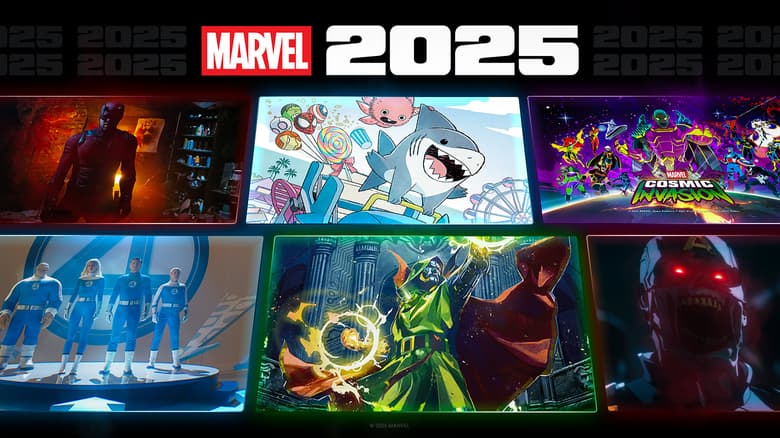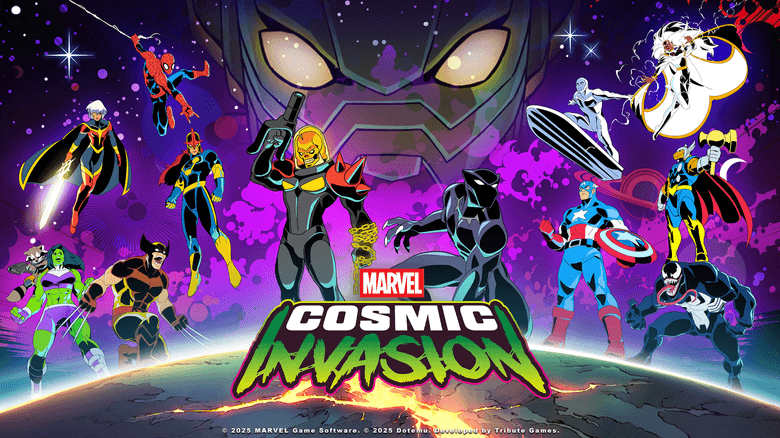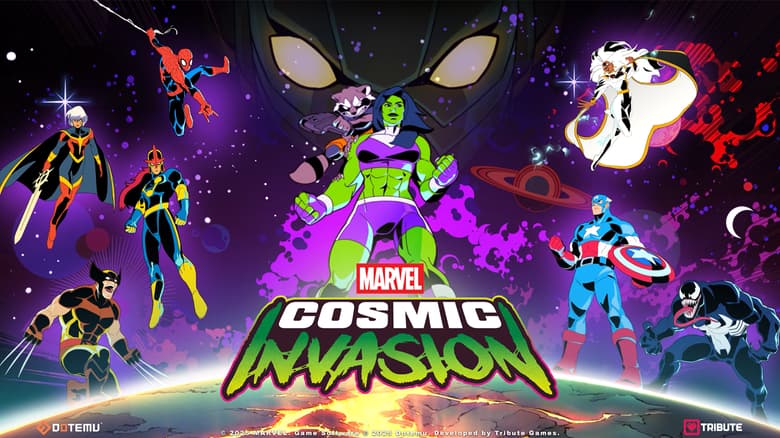Kieron Gillen on What Lies Ahead for the Eternals
Kieron Gillen gives a thorough assessment of his work to date with Marvel’s immortal heroes, as well as what he has planned in the months to come!
With their epic adventures headed to the big screen in short order later this year, the Eternals currently enjoy their highest profile since Jack Kirby introduced Ikaris, Sersi, and company back in 1976. On the comic book side of the equation, writer Kieron Gillen and artist Esad Ribic picked up the mantle of these immortal heroes earlier this year and launched the latest volume of ETERNALS. With one arc under their belt, already a devastating secret about the nature of their regeneration has rocked the world of these unique champions.

As ETERNALS enjoys a brief break in the action for the THANOS RISES and CELESTIA one-shot specials, we sat down with Gillen to get the inside track on the group's future. From the foundation of his plans to the impending reintroduction of Ajak and Makkari to the drama, the writer shared plenty of insight!
Prior to writing ETERNALS, what was your history with these characters?
Kieron Gillen: It’s tricky because they’ve been around for 45 years—they’ve been around. They’ve played parts in some big stories. The Celestials are really the breakout stars. It’s that weird thing where the most known thing about the Eternals is...not the antagonists, but a major part of the supporting cast. The Celestials are genuinely some of the best visuals [Jack] Kirby ever did. Every one of them is a classic design, they’re just fantastically weird looking. So my experiences as a kid were floating around the Eternals. I hadn’t read the initial series or the mini from the '80s, just the bits from AVENGERS or when the Celestials showed up in INFINITY GAUNTLET. They were just hanging out in the background—”who the hell are those guys?” That was the weird mystery of them.
I hadn’t really read about the Eternals until the real deep dive research for the series. I hadn’t read all of the Kirby ETERNALS, just some of it. I did read the [Neil] Gaiman/[John] Romita Jr. mini and the follow-up by the Knaufs. I read Jason [Aaron’s] mass suicide of the Eternals [in AVENGERS]. I was aware of them but not really a fan. I’ve always liked Sersi. When Sersi turned up with the Avengers I was interested.
How did the book come together? How did somebody with more of a passing interest in the Eternals come to be writing ETERNALS?
I was interested in coming back to Marvel and doing some work again and ETERNALS was a clean enough canvas that I knew I could make a go of it. There are enough really meaty ideas to develop, but it’s not like there is an inertia. Some books you can’t be as free because there’s such a level of expectation. With ETERNALS you have a bit more freedom. And there’s the challenge. Nobody has managed to get an Eternals book past issue #17. For me it’s always about finding a way to care. In the case of the Eternals, there’s a lot there. I think anybody who reads the comic can see. There’s new stuff every issue, that’s the great joy in it.
Most of my work for hire stuff, all of my Marvel stuff, always comes about when they come to me and say, “What do you think about this?” Explicitly as a writer, I don’t think about characters I don’t own. I’ve only got so many cycles in my brain, so I only think about what I’m able to write. I’m like an excitable dog; if you put a toy in front of me, I’m like, “Okay, let’s think about that.” I’ve got a history of writing gods and quasi-gods and building mythologies from the last time I was at Marvel. There’s also a lot of that stuff built into my creator-owned books. I’m a fairly logical person so I could see how I could do this job and why they would ask me. At the same time, the Eternals are not gods in the same way that Thor is. These are weird science fiction creatures. There’s obviously science fiction in Thor, but it’s higher up the mix with the Eternals.
Something else I’d never done at Marvel before was the complete polish up. Take the car that’s in the garage and put completely new parts in, see what works and what doesn’t, get it ready for the road. I’d never done that before with Marvel. I come into a book and I have aggressive takes on what it’s about. Starting from the first principle—I hadn’t really done that, and that’s sort of appealing.
It was also appealing that the movie was coming out. That made it interesting. I’m always interested in things I’ve never done. I’d never really done the new trade that’s in the shop for people who liked the movie. I’ve never been in the position to be that leading edge, the chance to pitch not only that you might want to read these comics, but all comics.
I also said yes [to ETERNALS] before [artist] Esad [Ribic]. I would have said yes just for Esad to be honest. [Laughs] I’m a huge fan of his work. But I said yes before Esad, so it wasn’t quite that self-serving.
Is there any sense of pressure given the renewed focus on the group or do you only see opportunity?
I guess it’s a sign that I’ve been around this for awhile, but I’m pretty chill. [Laughs] I remember when I first took over THOR from [previous writer J. Michael Straczynski] and that was a really high pressure job. JMS left, I jumped on the book, and I was a nobody writer then. I’ve told this story before, but I remember reading an online forum discussing who was going to follow JMS on THOR, and thinking “I don’t envy that guy…” and then a couple days later I got offered the job and thought, “I am that guy—dammit!” It was [writer] Matt Fraction who told me not to worry about it and asked, “Do you have a story to tell or not? Get off the Internet.”
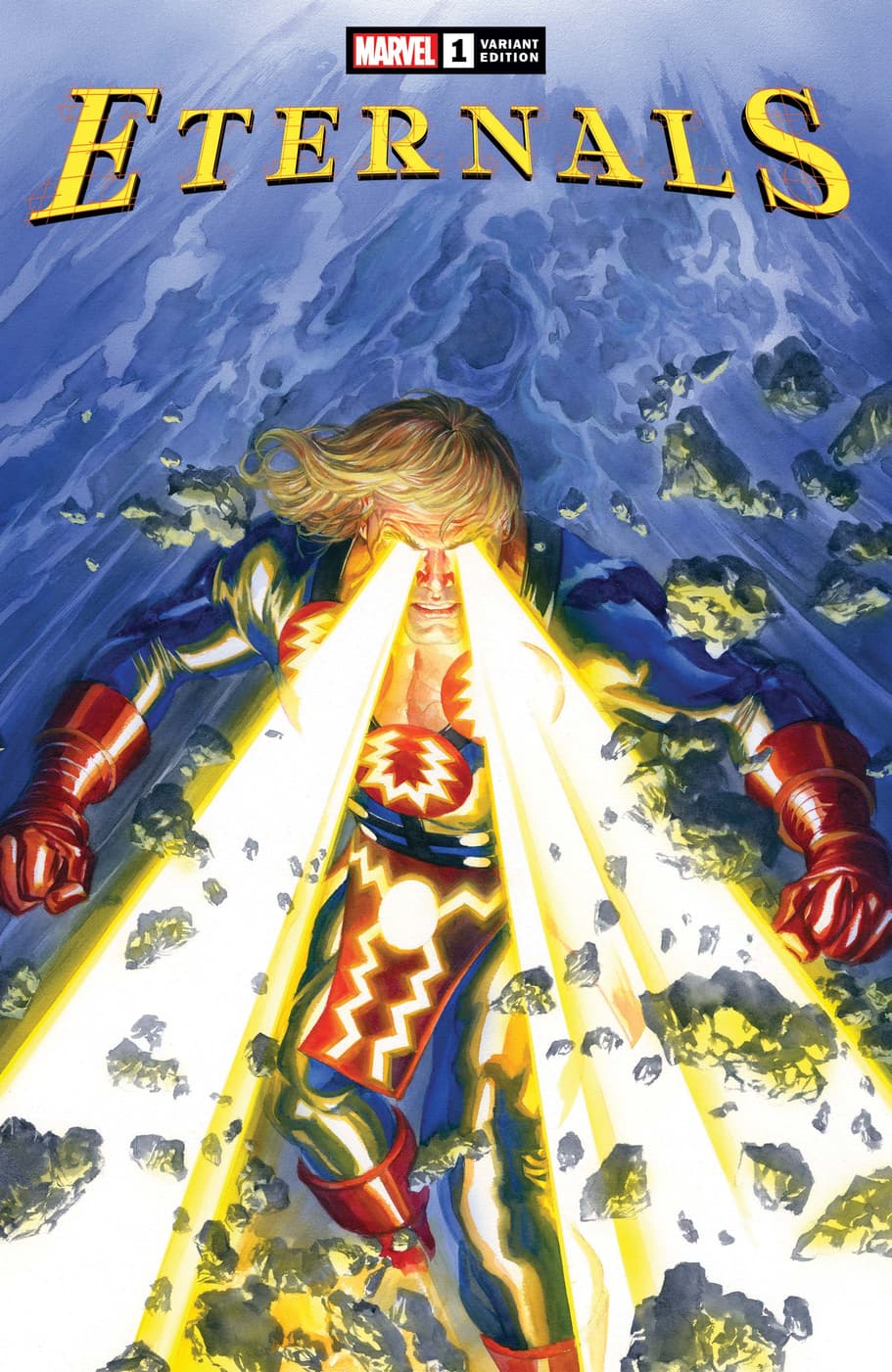
With one arc in the bag, what’s the mission statement for ETERNALS? What is this book about?
I said early on that I wanted it to be “What are the Eternals?” because they don’t really have a niche of their own. The niche of gods is taken and the idea of being mistaken for gods is less interesting in a world where there’s actually Thor. So I decided instead they’re angels. The gods are the Celestials, the Deviants are very clearly demons, and the Eternals are unchanging figures who are here to protect us from the demons. The idea of repositioning them as guardian angels gave them a niche. That’s one part, and you sort of see that in the first issue.
I’m also interested in them as a society. They’re not the X-Men. X-Men is about a nation, but it’s really about groups of friends and family. The Avengers are basically an office, it’s a procedural, they’re a group of people brought together to do a job. Spider-Man is just a guy. [Laughs] Eternals is a society. There’s 100 of them. That was always up front. They’re a structure. That’s the appeal.
What I think the Eternals really lacked is tragedy. They lacked Uncle Ben. There’s nothing bad about being an Eternal. That sadness is where Marvel characters are. Spider-Man is the most iconic Marvel character because he got his powers and then he learned that with great power comes great responsibility because he got his uncle killed. If you go through all the Marvel characters, there’s always that. There’s the feet of clay. The Eternals lacked feet of clay. So I gave them feet of clay. Any time an Eternal dies, they come back to life, but it costs them a random human’s life to do so. That’s an awful weight and I love it as an idea. Some of the Eternals just don’t care, and they’re the bad guys. But imagine if Spider-Man had that.
On the meta side, people are less interested in death when it comes to Super Heroes now. What [Jonathan] Hickman did with the X-Men was just to take [death] off the table. My idea with the Eternals is flipping that a bit. They’re characters who are afraid to die because they are heroes. They don’t want that to be on their conscience. In the case of Ikaris, now he knows because Toby died, but how many other humans have died for him? Now they have the proper Marvel Universe guilt and shame and regret. That’s what I wanted to give them and that’s where we are. Ikaris has a line where he’s like, “How can I fight like I don’t care if I live or die?” He hasn’t cared about being punched in the face for hundreds of years.
So what can we expect coming in the second arc and beyond?
By the end of the first arc, here are the Eternals. Where we go now is these unchanging beings who are trying to change. They’ve left their society and gone to join the Deviants, their ancient enemies. Kirby immediately deconstructed “Eternals are good, Deviants are bad, they have to fight.” The Deviants are quite noble in places. You meet characters like Karkas and The Reject, the Deviant who looks like an Eternal. Anyways, our Eternals have left to join the Deviants, and that’s where we pick up.
The second arc is about the Deviants, how the Eternals relate to the Deviants. Kro is one of the more prominent Deviants who has had an on-again off-again affair with Thena for thousands of years. What on Earth is the point of the Deviants? Why did the Celestials make them? In the Kirby books, a lot of the Deviants thought they were like popcorn, “The Celestials just like the way we taste,” and that’s depressing. Who wants to think that about themselves? The second arc is about how the Deviants view their relationship with the world. Because they’re an oppressed people. They’ve been around for a million years—every country on Earth has periods where they’ve been off. Maybe that’s not true...but most countries have had periods where they’ve done stuff.
Thanos is also still around, exploring his connection to the Eternals. ETERNALS: THANOS RISES is a killer special about how he was born. It’s very depressing. [Laughs]
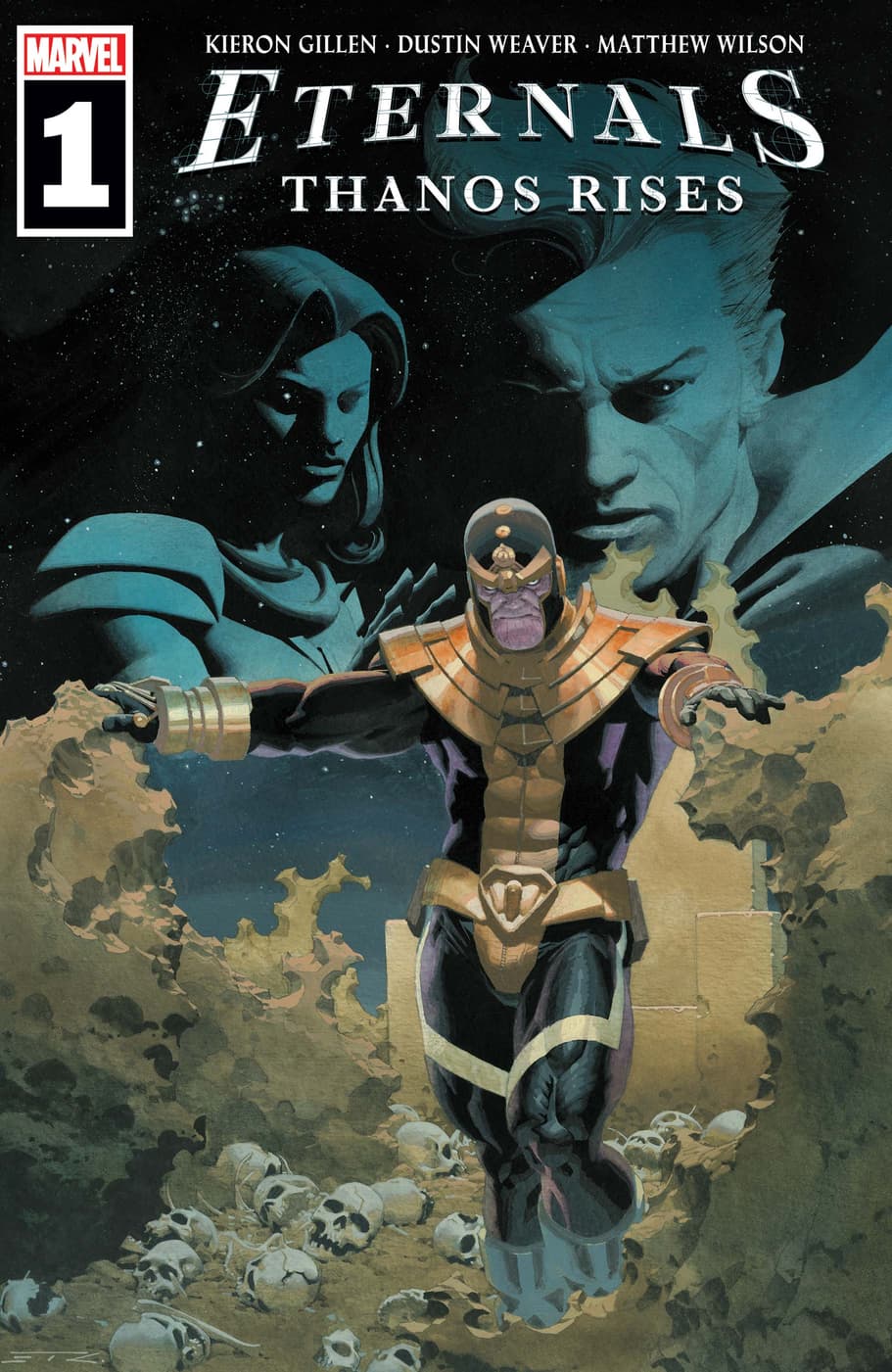
Since you brought him up, let’s jump over to Thanos for a second. This is a big character who has not traditionally been involved with the Eternals, but he has a high profile. When you took on ETERNALS, were you told Thanos was going to be in the book or is that something you came up with on your own?
I came up with that. I pitched it. Yeah, he’s a big character, that’s why I wanted him! [Laughs] He’s an important character. I try to treat continuity as mythology. Mentor and Zuras at one point went to war—what did they go to war over? I tried to tie everything together. What they went to war over in my head is that Mentor, AKA A’Lars, wanted to have kids. Eternals are able to have kids and add to The Machine. That’s what the war was over. My story became “and the first kid they had was Thanos.” Should Eternals have kids or not? Zuras said no, Mentor said yes, so Zuras gets a lot of “I told you so.” [Laughs] The Marvel Universe had already made Thanos part of the Eternals, they’d just never done the actual story. He’s a big character and I felt we would get a lot of charge out of seeing them together.
If you’re fighting Thanos, it’s something serious, and when people see him, they get it’s a big deal, it’s not just the usual Eternals story where they’re in their own corner. I have deliberately not shown a Celestial. Clearly I want to do something with them eventually, they’re on the covers. [Laughs] I want to look at the Eternals from different angles.
Tell me more about THANOS RISES. How does this story tie into the history of the Eternals and the bigger picture?
This is a story by itself. This is the story of the Titanos schism, how Titan came to be, the arguments they had. We see how the war ended. We see A’Lars go off by himself, how Sui-San ties in and them trying to have a kid. They made a whole species up there on Titan, but it wasn’t really true Eternals. They’re Titan Eternals, they’re not real Eternals. Druig rolls his eyes at Thanos in the next arc—he’s basically a hick. [Laughs] “We’re the real Eternals, don’t you get it?” How did they manage to circumvent the code of the Eternals? How did they manage to make someone like Thanos? It’s what they overcame and then you get Thanos at the end of it. And you find out what happened to A’Lars. Thanos killed A'Lars, but when an Eternal dies, they come back. So what did the Eternals do with A’Lars when they got their hands back on him? It all speaks to something that started positively and ended really bad for them, it’s a really sad story.
And Dustin Weaver drew it!
It’s so good! There’s a double page spread a few pages in that’s just ludicrous. You see this on the cover, so I can talk about it, but you see Eternals riding into battle on [dinosaurs] with fusion engines on their backs. It’s a few minutes out of the last battle in Lord of the Rings. When I do action in the flashbacks, that’s what I’m trying to get.
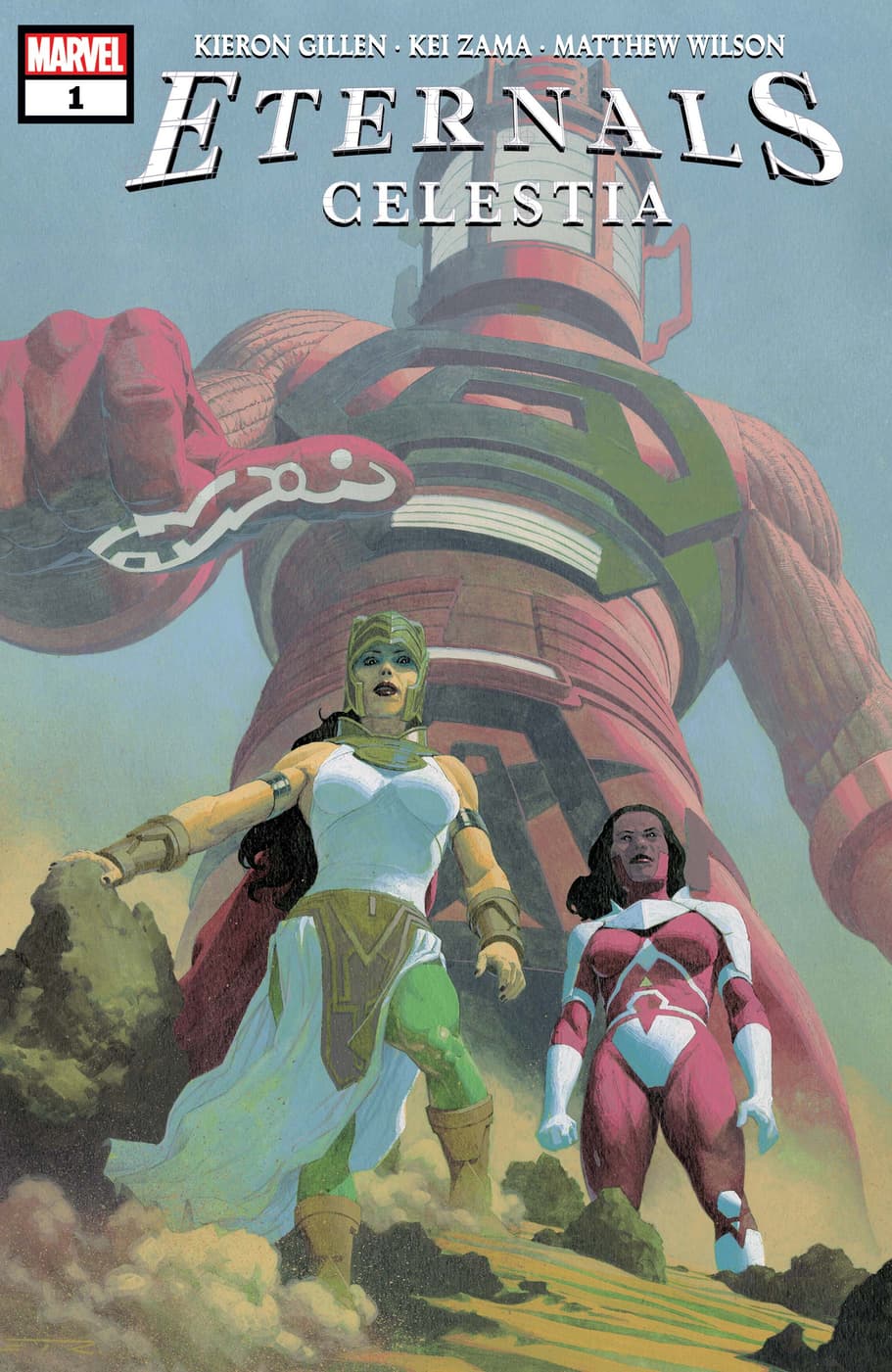
Tell us more about CELESTIA, the second one-shot.
It’s a little bit quieter. It takes place a billion years ago. [Artist] Kei [Zama] is great, her Celestials are great, her alien tech has a real vibe.
One of the problems with the Eternals is that the cast is enormous. The structure of the first arc was for each issue to focus on really one character, maybe a couple characters. Makkari and Ajak are such big characters in the mythology, but I never had the space to introduce them properly. Why did I start with Ikaris? He’s the most pure of heart, in some ways the simplest, so he’d be the most upset to find out the truth. [Laughs] He’s the one who’s most upset about it.
The recent continuity is that Ajak has been ghosted by the Celestials. Ajak is furious. Makkari is the Dreaming Celestial, basically the Celestial Jesus Christ was my understanding. Ajak is utterly furious and tries to murder Makkari. There’s some bad blood there. The Celestials then came back one last time and told Ajak she was worthless. That million years was for nothing. Makkari was turned into spare parts by a bunch of X-Men villains, including one I wrote, Mister Sinister. The arc of the story is this weird odd couple brought together by their grief trying to work out what their religion, their philosophy, does next.
Ajak and Makkari go on a pilgrimage to the giant Celestial that the Avengers are living inside. The flashback is about the first time that Ajak contacted the Avengers of 1,000,000 BC. At some point the Avengers and Eternals are both on Earth and have to size each other up for the first time. So we get two journeys to the Avengers, one Ajak at the start of her career, one in the present where she’s in this state of sad disillusion.
What’s it like getting to play with the prehistoric Avengers? You’re really one of the first writers who has gotten to do something with them besides Jason.
It’s only half the story, so I don’t get as much of them as I’d like. The first time I saw Ghost Rider on the wooly mammoth, I was like, “I’m in.” [Laughs] Comic books are amazing. I’ve written Odin before, but writing young Odin is fun. My favorite thing about writing the Eternals with the Avengers is that you get a slightly alien perspective on the Avengers. There’s some Avengers interaction in the second arc [of the main book] as well. What does The Machine make of the Avengers? That’s fun. What do the Eternals think the Avengers are for? There’s something invigorating about seeing somebody like Ajak, who’s a philosopher and a priest, encounter somebody like Odin. Seeing her scientific breakdown of them. The most fun is Jason picking up the ball and putting the Avengers in 1,000,000 BC and me throwing a curveball back. That’s the joy of a shared universe like Marvel. The “yes, and” of it. I wouldn’t have a great place for them to take a pilgrimage to if Jason hadn’t stuck a bloody Celestial in a wall!
Is there anything else you want to say about what’s ahead for readers in both the one-shots and then back with ETERNALS when it picks back up?
I wanted ETERNALS to be big. And with Esad drawing it, it’s never not going to feel big. I wanted it to have scale. With Lord of the Rings, you don’t need to read the appendices, but you know they’re there, and you know you’re in firm hands. That’s what the one-shots do. They pull back. I could write these specials forever. All these little details in the timeline, there are stories there. These are things that I think are utterly essential to know now. Each is a standalone story, but each tells you something really important to the current story.
I’m writing a third special at the moment—if I’ve already written two, you probably presume I’m doing more. It’s a similar thing, something really interesting to know, and it’s another bit in the timeline, a period where I definitely want to do more. A lot of the Eternals are terrible, but this is the worst one, and I’m including Thanos in that.
I’ve got a load of other Eternals I’ve referred to by name on that grid. I don’t want to rush introducing them, but there’s one I introduce in issue #8 who is a really cool, new take on things. It’s just a lot of fun. I’ve written up through issue #12. I’m still thinking about what exactly I want to bring into the mix next. We have a bounty of riches for our Marvel readers.
Read ETERNALS: THANOS RISES now, enter ETERNALS: CELESTIA on October 6, and prepare for the return of ETERNALS with issue #7 on November 3!
The Daily Bugle
Can’t-miss news and updates from across the Marvel Universe!



